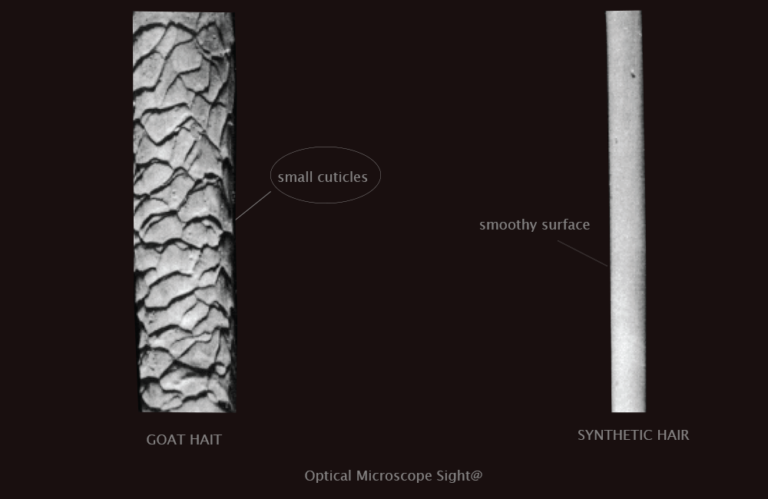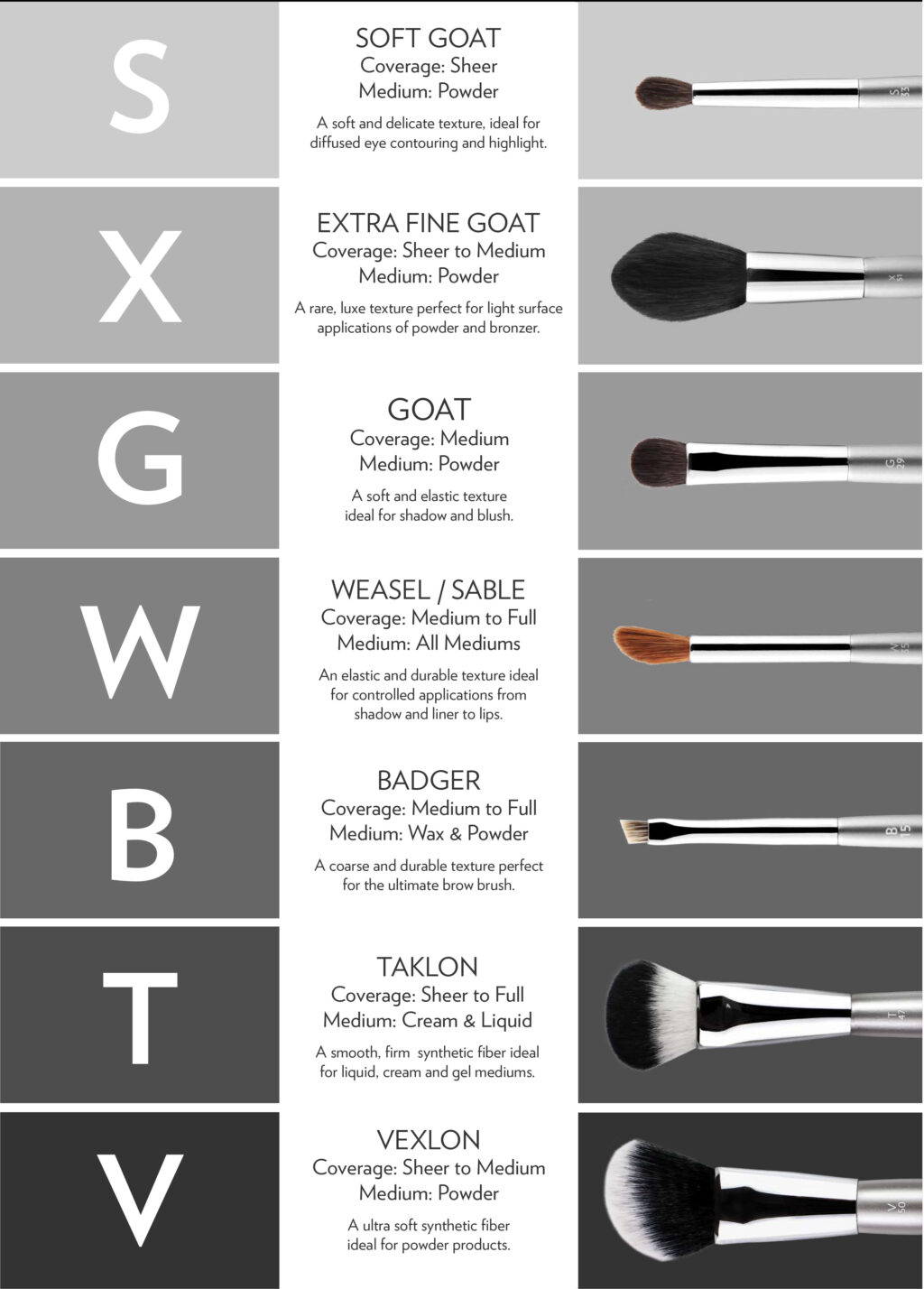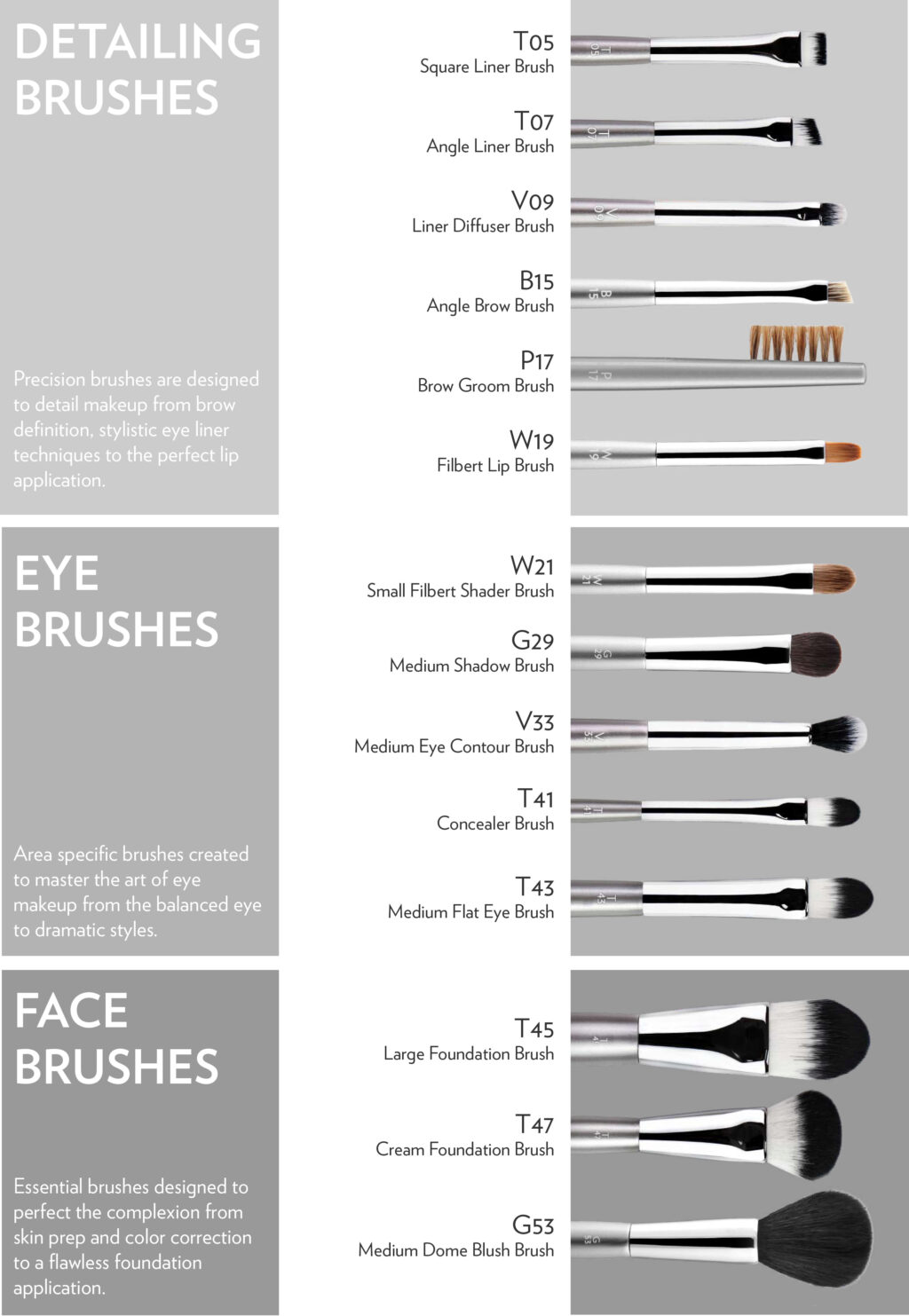This article is part of the makeup series.
When I first started doing makeup, I bought cheap drugstore brushes like everyone else. Some of those brushes, such as the REAL TECHNIQUES brand, are decent; others are pretty bad. I know it's a trend now to go all-synthetic, even for major brands, but I have never seen a synthetic brush that works as well as a natural brush for eyeshadow and powder. And drugstore brushes are all synthetic. They are also often badly made, can be too flexible, and lack some necessary sizes (even REAL TECHNIQUES' brushes suffer from this). I was amazed at how much my makeup skills improved just by using good brushes! Many of my frustrations with my makeup abilities weren't bad technique but bad brushes.
Makeup brushes are expensive. You can sometimes substitute art-store brushes, which are somewhat cheaper. But a good set of makeup brushes will last forever, with proper care, and are well worth the investment.
In this article, I talk about two of my favorite brush sets and touch a little on how to use them.
Brush Technique
Brush technique comes from proper instruction, practice, experiment, and above all, by watching people who are better at makeup than you are. You can't learn it all from reading. But I do have a few suggestions.
People often wonder what brush they should choose. But you also want to let the brush do the work. Even if you pick the right brush shape and size, if you use too much pressure, every brush turns into a blob. And it's possible to use too little pressure, "tickling" the client instead of applying makeup. Your strokes should have intention and definition while not distorting the natural shape of the brush.
Watch how the brush applies the makeup. Is it covering too much area? Next time, use a smaller brush for that task. Does it not suit the shape you want? Try a different shape. Is it too soft or too hard? If you listen to your brush, it can become one of your most important teachers.
It's natural to use a wiping motion when applying shadows. It's often better to pat the shadow on, then blend it. The shadow goes on better, and you are doing it with more intention.
You've probably heard that blending is essential. I find the best way to blend is to use a clean brush. I keep my blending brush clean and never use it to apply the product. Instead, I apply the shadow with the brush of my choice, then switch to a nice, clean fluffy brush for blending. When my favorite blending brush is too large for the area I want to blend, I apply the makeup, clean off the application brush and use it to blend. It's amazing how well this technique works.
Layering shadows on top of creams make the colors more intense. But it can make blending more difficult. I find setting the cream with a translucent powder, then layering and blending the shadows on top of the powder works much better.
Finding Good Brushes
My first excellent bushes were made by Robert Jones Beauty. Robert was my primary makeup teacher. He is a wonderful teacher and a fantastic makeup artist. I bought his brushes because I wanted my makeup to look like his. That's when I learned that not only do you need good brushes, but you also need knowledge and lots of practice. But I still remember the first time I applied shadow with a real sable brush - what a difference just using the right brush made! I bought them a few at a time because they were expensive, but I've never regretted it.
I've learned much about brushes since then and added more than a few to my collection. They remained my sole favorites until I discovered the ones from ESUM. Alphonse Wiebelt, a fantastic makeup artist, is the designer. Alphonse learned his craft by working with my favorite makeup artist, Kevin Aucoin. It's no coincidence that the best brushes are made by practicing makeup artists.
Brush Hair
Brushes are made from both synthetic and animal hair. There is a lot of pressure on brush makers from vegans to make only synthetic brushes. I love animals and hate me, if you must, but I have yet to try a synthetic brush that does as good a job with eyeshadows as a natural hair brush. Perhaps someday, technology will make a synthetic brush that is equal to a natural fiber brush, but at present, there is simply no comparison.
Just because we use natural hair brushes doesn't mean we have to be monsters. No animal should die so I can have a great makeup brush, and no animal dies just to make an ESUM brush. They use shaved hair or hair from animals who would have died anyway.
The ESUM Natural Hair Brushes
The care ESUM uses in selecting its raw materials is extraordinary. In addition to being responsibly sourced, all of the hair used by ESUM is grade A, first cut, virgin hair, the highest quality that you can get. ESUM insists on specific breeds. They also specify the precise place on the animal they want the hair from. This ensures quality and keeps the brushes consistent from one manufacturing run to the next. Should you need to replace your current ESUM brush in a year or two, you can be sure that the next one will be similar to the one you are using today.
Why Natural Hair is Better for Some Things
The cuticle layer makes natural hair work better for powders. Cuticles are little scales that occur naturally during hair growth. Their rough surface on the hair holds onto loose shadows and powders. Artificial hair, such as the Taklon fiber used in ESUM's (and most others) makeup brushes, is a smooth cylinder. Here's a magnified picture of goat hair and Taklon:

Manufacturers curl the hair in synthetic powder brushes, so they hold powder better. Curling helps but does not come close to the holding power of the cuticle layer. And every animal species has a unique cuticle layer which creates different effects when you use them in a brush.

That's why ESUM uses different kinds of hair in their brushes. Sable hair (weasel) has a very open cuticle and efficiently gathers and deposits shadows. Extra fine goat hair has a much finer-grained cuticle, so its application will be sheerer. You can tell what hair each brush has from the letter in its name. Here's a chart:

 To see the kind of differences hair makes to makeup application, compare two similar brushes. the large sable contouring brush and the
medium soft goat contouring brush:
To see the kind of differences hair makes to makeup application, compare two similar brushes. the large sable contouring brush and the
medium soft goat contouring brush:
The S33 (soft goat) brush has a fine cuticle and a "windshield wiper" shape. It's similar to a watercolor brush and has a fluid feel. It lays down an even but sheer coat of powder.
The W35 sable brush has a much more open cuticle, holding much more powder and depositing it well. It's a much sturdier brush hair. To experience this, you can try a "whip and snap" test: Take the S33 brush and hold it upright in one hand. Then take the index finger of your other hand and move it through the hairs. As you move the finger through the strands, they will bend (this is called the whip), and then, when the finger has pushed through the hair, it will rebound back (this is called the snap). Now do the same whip and snap test with the W35 sable brush. You will notice a dramatic difference as the sable brush is much sturdier and snaps back with much more energy.
The soft goat hair of the S33 brush is the sort of hair that they use for art brushes that have only four hairs and are so expensive they lock them up in cabinets at art stores. Imagine using the S33 brush for something other than makeup. You might use it to paint some delicate eyelashes on a painting or as a fine line detailing brush for acrylic makeup. Used as a makeup brush, it will apply shadow beautifully, lightly, and elegantly.
The W35 sable brush will stick with you as you execute that smokey eye, winged eyeliner, or signature red lip. It won't fan out or spread as you use it. It will be your best friend for life. It's not surprising that Sable brushes are a staple of every fine natural hair makeup brush set.

Classic shapes.
Here are pictures of a few of the brushes. All the classic shapes are included, along with a few new interesting ones. These are only a few examples - the entire ESUM brush set contains 33 brushes!


Construction
These brushes are unusually sturdy, which is a plus, but it makes them unusually heavy. The weight is primarily due to the ferrule, which is solid brass. Most brushes have aluminum or plastic ferrules. It looks great and does a fantastic job of holding the brush shape. You might find these brushes too heavy to carry around in your purse. Robert Jones' brushes have similar construction but are smaller and not as heavy.
The handles are made from oil-cured birchwood. Birchwood is the responsible choice, and oil-curing makes the wood resistant to expanding and contracting when wet.
Each brush is built with a "knuckle," which makes it very comfortable to hold, and the brushes are perfectly balanced. Many of the handles are on the long side. Long handles are good and bad. They are good for doing makeup on clients because clients don't like your hand in their faces. The long handle can get between you and your mirror when doing your makeup.
Manufacturing
As hair grows, it loses keratin, causing hair ends to become slightly tapered and naturally soft - desirable features in a brush. Unfortunately, machines can't orient hair to take advantage of the natural taper, so they shape the heads by cutting the hair. That leaves a hard edge which can hurt the skin and cause breakouts. All of ESUM's brushes are handmade. The craftsman gathers the proper amount of hair to make the head and places it upside down in a hand-carved mold. The hair is then hand-tied and removed from the mold. The craftsman then uses a unique tool to groom the brush and remove excess hair. If the brush needs additional shaping, he doesn't cut the hair. Instead, he adjusts it from the bottom of the brush until the shape is correct. The craftsman shapes all the brushes using this method, so it is never necessary to cut the tips.
Finally, only the synthetic hair brushes are dyed. They leave the natural hair in its natural state for maximum softness.
Brush Care
To clean natural hair brushes while you work, I recommend spraying a cloth or paper towel with the cleaner of your choice (my favorite is Japonesque) and then gently wiping the brush hair from the base of the hair to the tip. Spraying the cloth instead of the hair avoids the risk of getting any cleaner down inside the ferrule, which could weaken the glue and cause the brush to fall apart.
I do not recommend using brush cleaner on any synthetic brush. These cleaners contain alcohol, which causes synthetic hair to get brittle or melt. If you need to clean your synthetic brushes between clients, shampoo them as you would at the end of the day. Being synthetic, they will dry quickly.
Always shampoo your brushes at the end of your work day. For natural brushes, I like to use solid brush cleaners; Japonesque makes a nice one. But any mild bar soap with no fragrance will work. You can also use mild hair shampoo, but avoid baby shampoo, which is very acidic. For synthetic hair, I use Dawn dishwashing soap.
Hold the brush upside down (hair pointing down) and place only the hair under running water, never the handle or the ferrule. It is crucial to avoid getting water inside the ferrule. Water destroys the glue that holds the brush together and will destroy your brush. After wetting the brush carefully, swirl it on the sold cleanser, then massage and lather it with your fingers or a slightly rough silicon brush mat. Then rinse the soap out of the hair, then squeeze out the water with your fingers as you reshape the hair. If necessary, comb it gently with the ESUM 13 Styling tool. If you have an antibacterial spray, you can use it now. Then lay the brush flat on a towel or hang it upside down from a rack. Never put a wet brush in a storage cup. You risk having water drip down from the hair and entering the ferrule, which will reduce the life of your brush.
Incidentally, brush guards are one of the best accessories you can own. Guards help all brushes keep their intended shape, and they are incredibly inexpensive. Just squeeze out the water from the brush with your hand, shaping it as you do so, then slide the guard onto the brush.
Never use conditioner on brushes. The conditioner works by coating the hair, covering the cuticle, and reducing the brush's effectiveness.
Comparison with Other Brushes
The ESUM brushes are extraordinary. Among the brushes I own, the only serious competition is from Robert Jones' Brushes. Some of Robert's brushes are not quite as soft as the ESUM set; they may have been machine shaped. While Robert's brushes are very high quality, they only contain Sable and synthetic hair (typical of most brush sets). Having experienced the variety of hair in the ESUM brushes, I miss that in Robert's.
On the other hand, Robert's set contains the most practical shapes. You will probably use every brush of Robert's in a makeup session. The ESUM set contains more specialty brushes. They are nice to have, but you could live without them. And Robert's brush number 41 and his big fluffy blending brush number 28 don't have equivalents in the ESUM brush set, and I use these brushes (and many of Robert's brushes) all the time.
I also own quite a few MAC brushes. I love MAC, and I am a MAC pro artist and proud of it. I'm sorry to say that I have never really been blown away by their brushes. The new synthetic line of Mac brushes leaves me cold.
Other than missing a couple of brush shapes, the only real problem with the ESUM brushes is the price. Their quality is beyond compare. They have the most beautiful hair, great handles, and gorgeous ferrules. Everything is handmade with exquisite craftsmanship. They are great brushes. I love them. Unfortunately, you have to pay for excellence, and this much excellence comes at a high price. But you can buy a few at a time, and most people won't need the entire set. They also go on sale from time to time. So if you have money, patience, or just someone who loves you so much, they will give them to you; the ESUM brushes are my top recommendation: ESUM Brushes Website
On the other hand, if you want a wonderfully usable set of brushes, well thought out and well made without spending an enormous amount of money, then the Robert Jones' Brushes are the ones for you.
What brushes do you like? I'm always interested in talking brushes! Please send me your thoughts.